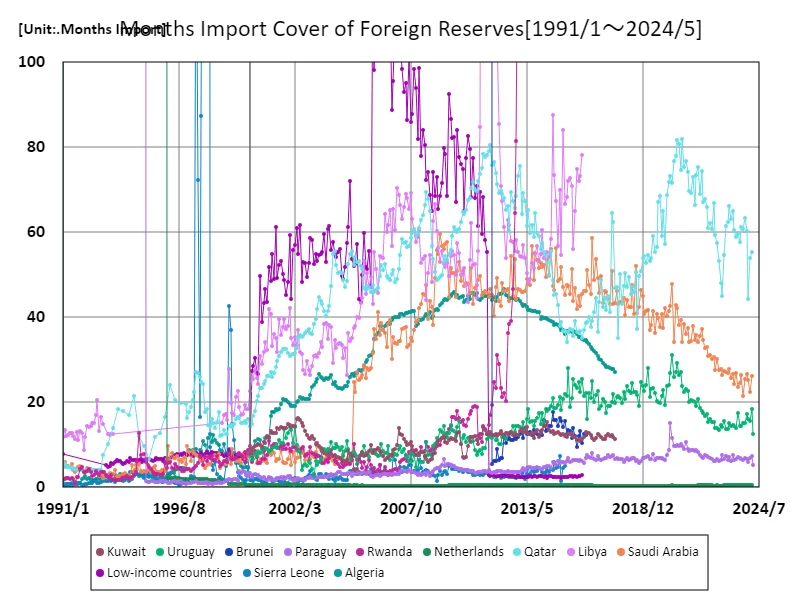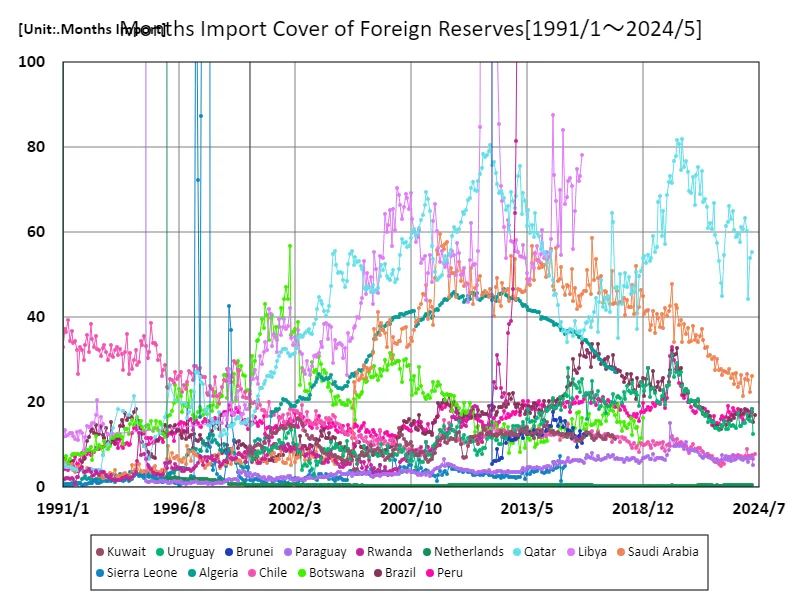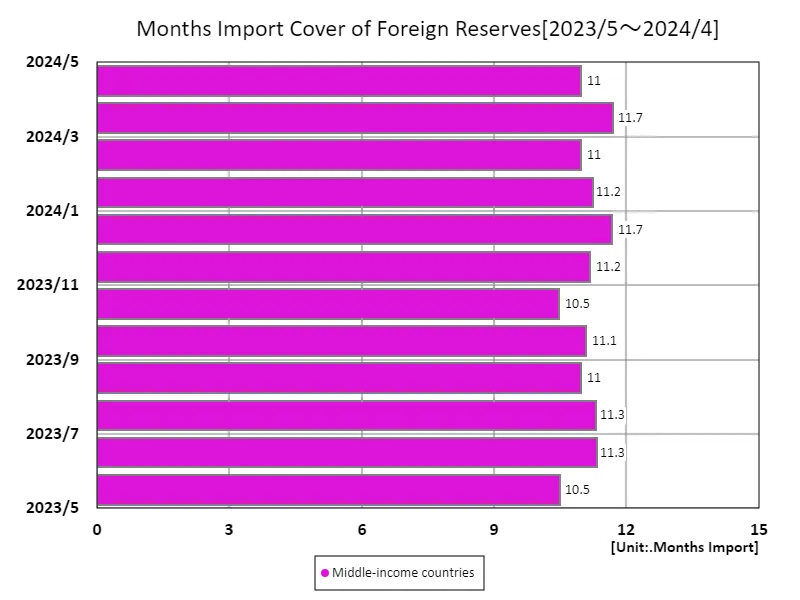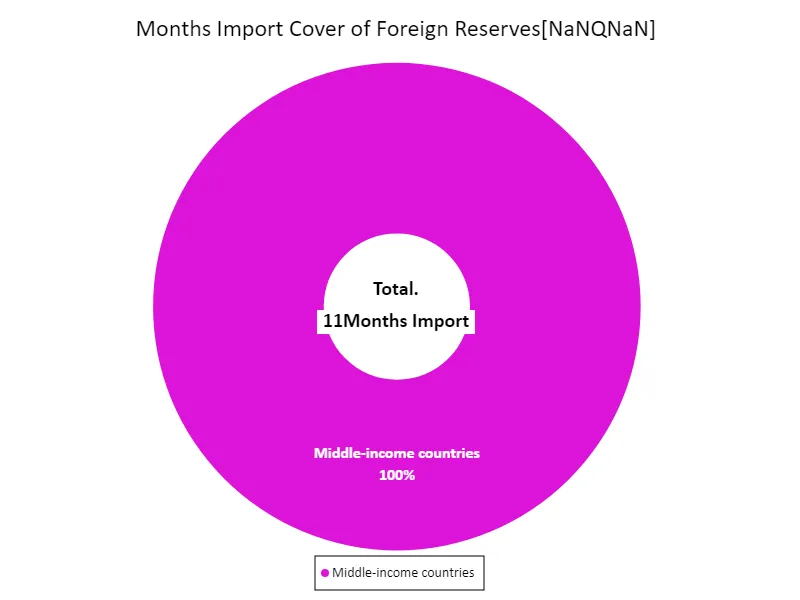- Abstract
- Number of months of foreign exchange reserves to cover imports
- Number of months of foreign exchange reserves covering imports (nations around the world)
- Months of import coverage of foreign exchange reserves (by income, latest year)
- Months of import coverage of foreign exchange reserves (region, latest year)
- Reference
Abstract
The number of months of import coverage of foreign exchange reserves is an important indicator of a country’s economic stability and international credibility. Uruguay’s high level of 12.4 months in April 2024 suggests the country’s foreign exchange reserves are solid, easing its reliance on imports. The data will be closely watched as an indicator of how emerging markets, in particular, can improve their resilience to external shocks and currency instability. Looking at past trends, the adequacy of foreign exchange reserves is closely related to economic growth, and is influenced by stable economic policies and the development of foreign trade. In addition, countries with large foreign exchange reserves tend to gain the trust of investors because they have the ability to respond quickly in the event of a financial crisis. Furthermore, resource-rich countries and countries with stable economic foundations tend to have high coverage months. Overall, the months of import coverage of foreign exchange reserves is an indicator that reflects a country’s economic strategy and external credibility, and is an important indicator of how countries are adapting to the external economic environment and maintaining stability.
Number of months of foreign exchange reserves to cover imports
The number of months of import coverage of monthly foreign exchange reserves is a key indicator of a country’s economic stability and external reliability, and some interesting trends emerge through the data from January 1991 to April 2024. In particular, Kuwait’s record of 48,200 import months in March 1991 symbolizes the country’s substantial foreign exchange reserves and its subsequent economic stability. However, the current figure has fallen to 23.7% compared to its peak, highlighting the need to adapt to changes in the economic environment and market. The general trend over this period has been that countries with larger foreign exchange reserves have tended to be more resilient to financial crises and external shocks. On the other hand, countries that are easily affected by fluctuations in resource prices and the international economy may see a decline in their foreign exchange reserves. In addition, some emerging countries are increasing their foreign exchange reserves as their economies grow, and they are gaining the trust of investors by pursuing stable policies. Overall, months of import coverage of foreign exchange reserves is an important barometer of a country’s economic health and an important indicator that reflects changes in economic policies and the international environment. Attention will likely continue to be focused on each country’s economic strategies and market fluctuations.


The maximum is 48.2Gonths Import[1991年3月] of Kuwait, and the current value is about 23.7m%
Number of months of foreign exchange reserves covering imports (nations around the world)
The number of months of import coverage of foreign exchange reserves is an important indicator of a country’s economic stability and international credibility. Data covering the period from January 1991 to May 2024 shows that Kuwait recorded the highest import month of 48,200 in March 1991, indicating the strength of the country’s economic foundation. However, the current figure is 23.7% lower than the peak, which is likely due to changes in economic conditions and resource dependency. A general trend during this period has been that countries with large foreign exchange reserves tend to be more resilient to financial crises and external shocks, but many of them are also more sensitive to fluctuations in resource prices. In particular, oil-dependent economies like Kuwait are vulnerable to international market influences and require flexibility in their economic policies. In addition, some emerging countries are increasing their foreign exchange reserves as their economies grow, and they are gaining international credibility through stable economic policies. Overall, the number of months of import coverage of foreign exchange reserves is an indicator that reflects changes in a country’s economic policies and the international economy, and attention will continue to be focused on each country’s economic strategies and market trends.


The maximum is 48.2Gonths Import[1991年3月] of Kuwait, and the current value is about 23.7m%
Months of import coverage of foreign exchange reserves (by income, latest year)
The number of months of import coverage of foreign exchange reserves is an important indicator of a country’s economic stability and resilience to external shocks. Data for May 2023 shows that upper-middle-income countries have the highest life expectancy at 12.8 months, compared with an average of 9.08 months and a total of 27.3 months. This result suggests that middle-income countries have maintained relatively stable foreign exchange reserves. Historically, countries with abundant foreign exchange reserves have tended to be more resilient to fluctuations in international markets, while countries with resource-dependent economic structures tend to be more vulnerable to external shocks. The reason why upper-middle-income countries have a high number of months of coverage is likely due to stable economic growth and appropriate monetary policies. In addition, strengthening foreign exchange reserves also has the effect of enhancing a country’s international creditworthiness and encouraging investment from abroad. Emerging market countries in particular are pursuing policies to increase their foreign exchange reserves, thereby strengthening their resilience to fluctuations in the international economy. Overall, the number of months of import coverage of foreign exchange reserves is an important indicator that reflects a country’s economic strategy and changes in the international environment, and attention will continue to be focused on each country’s policy trends and market impacts.


The maximum is 11.7Months Import[2024年3月] of Middle-income countries, and the current value is about 93.7%
Months of import coverage of foreign exchange reserves (region, latest year)
According to April 2024 data, upper-middle-income countries had the highest months of import coverage of foreign exchange reserves at 11.9 months, while the overall average was 8.48 months and the total reached 25.4 months. These figures suggest that upper-middle-income countries have relatively robust foreign exchange reserves and are more resilient to fluctuations in the international economy. Strengthening foreign exchange reserves enhances economic stability and fosters investor confidence. Upper-middle-income countries are pursuing policies to support sustainable economic growth, which is helping to increase their foreign exchange reserves. In addition, these countries are often realizing increased foreign exchange earnings due to the development of their manufacturing and service sectors. On the other hand, with the average value being 8.48 months, foreign exchange reserves overall are not sufficient, and resource-dependent economies in particular are vulnerable to market fluctuations. This requires rapid response when external shocks occur. Overall, the number of months of import coverage of foreign exchange reserves is an important indicator reflecting a country’s economic policies and international situation, and will likely attract increased attention for future economic strategies and market trends.


The maximum is 11Months Import of Middle-income countries, the average is 11Months Import, and the total is 11Months Import



Comments